#kalitta air
Explore tagged Tumblr posts
Text
No. 2 - Kalitta Air
I’m really thrilled by how much you all enjoyed my Lufthansa rant. Here’s something...a little different. Just to rub in that I don’t inherently hate liveries just for having a mostly white fuselage, I wanted to talk about an example of that being done a lot better. I will also be doing so in a length which will probably be a bit more typical of this blog. I hope you all enjoy it regardless!
Kalitta Air (formerly Connie Kalitta Services and American International Airways; callsign “Connie”) is a cargo airline headquartered in Ypsilanti, Michigan. You see their planes around a lot if you randomly click on flightradar24 flights, especially over North America, but they don’t carry passengers, so to my knowledge they’re not a household name. At least, the friends I surveyed had never heard of them.

(image: kalitta air)
But their low profile conceals some pretty stylish planes. So, let’s discuss!
Like I said, I don’t blanket dislike mostly-white liveries just because most of them are super boring and Lufthansa’s in particular is terrible! So I wanted to follow it up immediately with an example of a mostly white livery which I really like - Kalitta Air’s sleek and iconic paint job, which the airline adopted (as far as I can tell from digging around) in the late 1980s.
It truly feels like Connie Kalitta’s main gig as a racecar driver transferred to the look of the planes with his name written on the side. (...what is it with racecar drivers and starting airlines? I mean, two nickels, but...)
The majority of Kalitta Air’s fleet are Boeing 747s, which does add to the look, in my opinion. Their fleet even contains the last 747-400 ever built! The iconography feels like it transitions well into the hump, and the entire thing looks balanced.
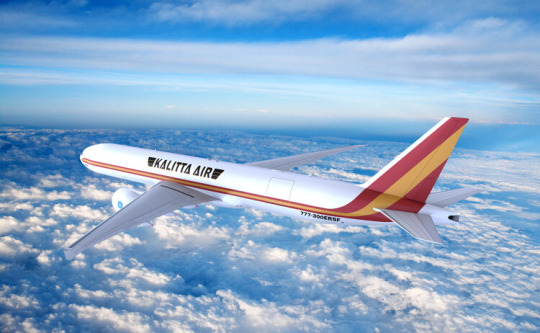
(image: kalitta air)
I’ll be honest, something is definitely lost on the remainder of the airline’s fleet, made up of Boeing 777s, in a pretty major way, but it doesn’t cancel out just how much I love the look of the 747s. Still, because the airline has kept this livery for so long, we can look back to the past to experience it on all sorts of shapes.
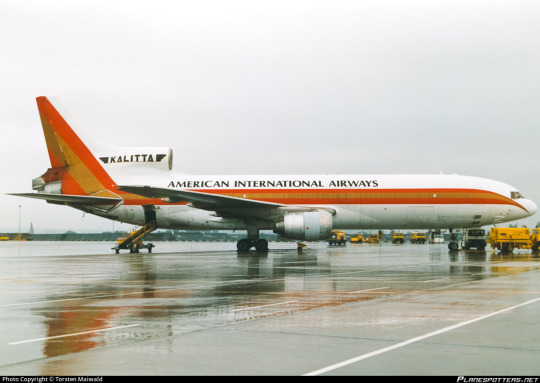
I can’t believe I’m saying this, but I still prefer the 747. That’s pretty incredible - I’m of the opinion that nearly all liveries look their best on a TriStar, so that opinion is a testament to just how incredibly good this livery looks on the Queen. It’s an acceptable-to-good livery on any plane, don’t get me wrong, but the core 747 fleet wears it transcendently well. (I am ignoring the 777s.)

If you’ve seen a Kalitta Air plane for more than a few seconds it’s likely the pictured N700CK, which got to flip a few assorted vehicles with her jet blasts in the 2007 Mythbusters episode “Supersized Myths”. Their 747s have been used in other media, but this is the main example. I think they couldn’t have picked a more striking plane to use.
Just look at the thing! The combination of red and gold makes it feel flashy and fast, a feeling which is added to by the swooping hockey-stick cheatlines which add a lot of interest to the fuselage with very little paint. It makes the plane feel streamlined and almost reminds me of the sort of paint jobs used on early high-speed trains.
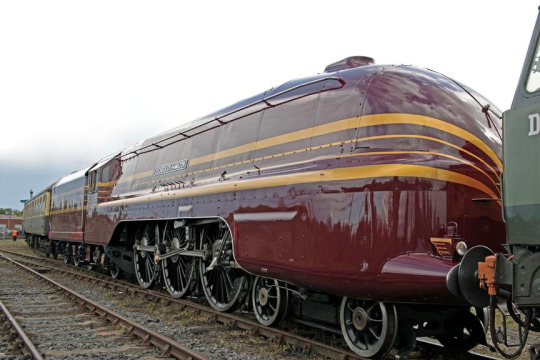
(image: Science Museum Group Collection)
The font itself even feels fast, while being massive and quite legible even despite the shape of the A, and framed nicely on each side by the little wings. It does look a little like if a racecar was a cargo plane, and I love it. It’s not exactly maximalist, but every detail from the letters’ even heights to the ratio of gold to red feels perfect.
If you’re going to do a mostly white paint job (and there are plenty of reasons that airlines generally prefer to), this is how you do it.
Final Grade: A
N.B. For the sake of my own mental health, I am not going to touch on the atrocious revision of two years ago in this post. At the least, it looks like they’re not repainting old airframes and they have a small-ish fleet so they’re not bulk-buying new ones or anything, which means this livery will probably be around for the remainder of the service life of many fairly new freighters. Because of that, I do not consider the classic hockey stick Kalitta livery to be retired, and will not be tagging it as such. That said, since it’s not their current livery for new planes, I also am not classifying it as a 2020s livery.
#tarmac fashion week#grade: a#era: 1980s#era: 1990s#era: 2000s#era: 2010s#region: north america#region: united states#kalitta air#cargo carriers
94 notes
·
View notes
Text
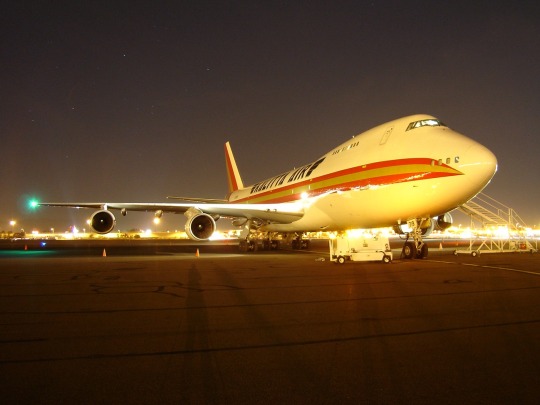
Kalitta Air B747 cargo aircraft parked on the West Cargo ramp at Phoenix Sky Harbor airport in mid-2000s.
0 notes
Text

airsLLide No. 16888: N619US, Boeing 747-251F, Northwest Airlines, Anchorage-Ted Stevens International, June 10, 1999
N219US was built in 1977 as a dedicated freighter for Northwest Orient Airlines and served with the carrier for exactly 30 years, through its merger with Republic Airlines including the brand name change to Northwest Airlines (to better reflect the acquired share in the US domestic market). When finally retired by Northwest at the end of May 2007, she was sold to Kalitta Air where she flew on for some more years. She was withdrawn from use in late 2010 only.
6 notes
·
View notes
Text
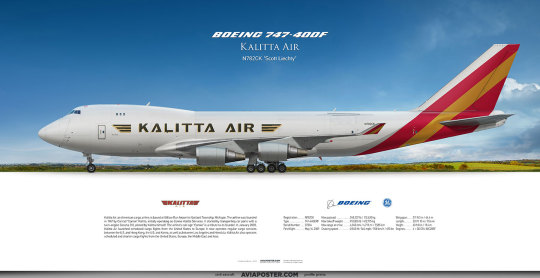
Boeing 747-400F Kalitta Air
Registration: N782CK Named: Scott Liechty Type: 747-4HQERF Engines: 4 × GE CF6-80C2B5F Serial Number: 37304 First flight: May 16, 2009
Kalitta Air, an American cargo airline, is based at Willow Run Airport in Ypsilanti Township, Michigan. The airline was founded in 1967 by Conrad “Connie” Kalitta, initially operating as Connie Kalitta Services. It started by transporting car parts with a twin-engine Cessna 310, piloted by Kalitta himself. The airline’s call sign “Connie” is a tribute to its founder. In January 2003, Kalitta Air launched scheduled cargo flights from the United States to Europe. It now operates regular cargo services between the U.S. and Hong Kong, the U.S. and Korea, as well as between Los Angeles and Honolulu. Kalitta Air also operates scheduled and charter cargo flights from the United States, Europe, the Middle East and Asia.
Poster for Aviators aviaposter.com
8 notes
·
View notes
Text
New planes bringing military aid from US and UK arrive in Ukraine
New planes bringing military aid from US and UK arrive in Ukraine
Two planes bringing military aid from the UNITED States and Britain arrived in Kiev, Ukraine, today. The Royal British Air Force Airbus A400M Atlas military transport plane and the American Kalitta Air Boeing 747 chartered by the US Armed Forces Transport Command arrived in Kiev today, according to western air traffic monitoring platforms. The British military plane was understood to have taken…

View On WordPress
0 notes
Text
What 10,000 horsepower does to a top fuel tire at launch.
TOP FUEL ACCELERATION PUT INTO PERSPECTIVE
* One Top Fuel dragster 500 cubic-inch Hemi engine makes more horsepower (10,000 HP) than the first 5 rows at the Daytona 500.
* Under full throttle, a dragster engine consumes 1.2-1.5 gallons of nitro methane per second; a fully loaded 747 consumes jet fuel at the same rate with 25% less energy being produced.
* A stock Dodge Hemi V8 engine cannot produce enough power to merely drive the dragster's supercharger.
* With 3000 CFM of air being rammed in by the supercharger on overdrive, the fuel mixture is compressed into a near-solid form before ignition. Cylinders run on the verge of hydraulic lock at full throttle.
* At the stoichiometric 1.7:1 air/fuel mixture for nitro methane the flame front temperature measures 7050 degrees F.
* Nitromethane burns yellow. The spectacular white flame seen above the stacks at night is raw burning hydrogen, dissociated from atmospheric water vapor by the searing exhaust gases.
* Dual magnetos supply 44 amps to each spark plug.
This is the output of an arc welder in each cylinder.
* Spark plug electrodes are totally consumed during a pass. After 1/2 way, the engine is dieseling from compression plus the glow of exhaust valves at 1400 degrees F. The engine can only be shut down by cutting the fuel flow.
* If spark momentarily fails early in the run, unburned nitro builds up in the affected cylinders and then explodes with sufficient force to blow cylinder heads off the block in pieces or split the block in half.
* Dragsters reach over 300 MPH before you have completed reading this sentence.
* In order to exceed 300 MPH in 4.5 seconds, dragsters must accelerate an average of over 4 G's. In order to reach 200 MPH well before half-track, the launch acce leration approaches 8 G's.
* Top Fuel engines turn approximately 540 revolutions from light to light!
* Including the burnout, the engine must only survive 900 revolutions under load.
* The redline is actually quite high at 9500 RPM.
* THE BOTTOM LINE: Assuming all the equipment is paid off, the crew worked for free, & for once, NOTHING BLOWS UP, each run costs an estimated $1,000 per second.
0 to 100 MPH in .8 seconds (the first 60 feet of the run)
0 to 200 MPH in 2.2 seconds (the first 350 feet of the run)
6 g-forces at the starting line (nothing accelerates faster on land)
6 negative g-forces upon deployment of twin ‘chutes at 300 MPH An NHRA Top Fuel Dragster accelerates quicker than any other land vehicle on earth . . quicker than a jet fighter plane . . . quicker than the space shuttle.
The current Top Fuel dragster elapsed time record is 4.420 seconds for the quarter-mile (2004, Doug Kalitta). The top speed record is 337.58 MPH as measured over the last 66' of the run (2005, Tony Schumacher).
Putting this all into perspective:
You are driving the average $140,000 Lingenfelter twin-turbo powered Corvette Z06. Over a mile up the road, a Top Fuel dragster is staged & ready to launch down a quarter-mile strip as you pass. You have the advantage of a flying start. You run the 'Vette hard up through the gears and blast across the starting line & pass the dragster at an honest 200 MPH. The 'tree' goes green for both of you at that moment.
The dragster launches & starts after you. You keep your foot down hard, but you hear an incredibly brutal whine that sears your eardrums & within 3 seconds the dragster catches & passes you.
He beats you to the finish line, a quarter-mile away from where you just passed him. Think about it - from a standing start, the dragster had spotted you 200 MPH & not only caught, but nearly blasted you off the road when he passed you within a mere 1320 foot long race!
That's acceleration!
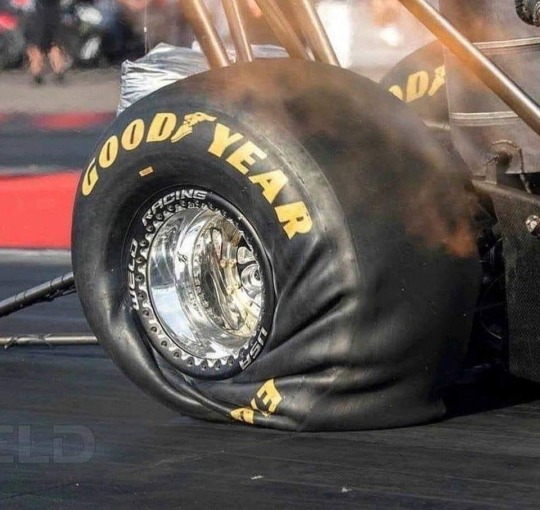
5 notes
·
View notes
Text
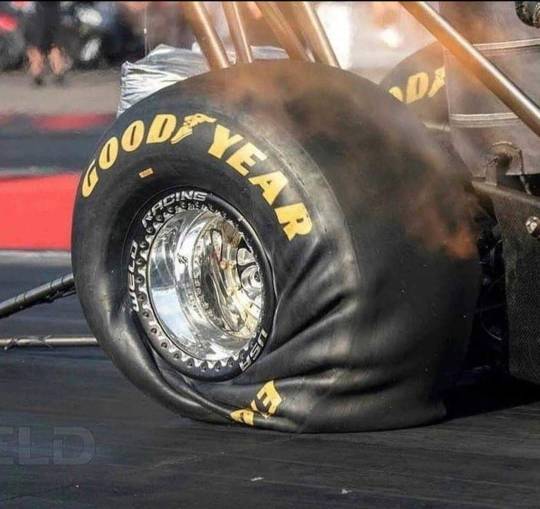
TOP FUEL ACCELERATION PUT INTO PERSPECTIVE This is what 10,000 horsepower does to a top fuel tire at launch.
* One Top Fuel dragster 500 cubic-inch Hemi engine makes more horsepower (10,000 HP) than the first 5 rows at the Daytona 500.
* Under full throttle, a dragster engine consumes 1.2-1.5 gallons of nitro methane per second; a fully loaded 747 consumes jet fuel at the same rate with 25% less energy being produced.
* A stock Dodge Hemi V8 engine cannot produce enough power to merely drive the dragster's supercharger.
* With 3000 CFM of air being rammed in by the supercharger on overdrive, the fuel mixture is compressed into a near-solid form before ignition. Cylinders run on the verge of hydraulic lock at full throttle.
* At the stoichiometric 1.7:1 air/fuel mixture for nitro methane the flame front temperature measures 7050 degrees F.
* Nitromethane burns yellow. The spectacular white flame seen above the stacks at night is raw burning hydrogen, dissociated from atmospheric water vapor by the searing exhaust gases.
* Dual magnetos supply 44 amps to each spark plug. This is the output of an arc welder in each cylinder.
* Spark plug electrodes are totally consumed during a pass. After 1/2 way, the engine is dieseling from compression plus the glow of exhaust valves at 1400 degrees F. The engine can only be shut down by cutting the fuel flow.
* If spark momentarily fails early in the run, unburned nitro builds up in the affected cylinders and then explodes with sufficient force to blow cylinder heads off the block in pieces or split the block in half.
* Dragsters reach over 300 MPH before you have completed reading this sentence.
* In order to exceed 300 MPH in 4.5 seconds, dragsters must accelerate an average of over 4 G's. In order to reach 200 MPH well before half-track, the launch acce leration approaches 8 G's.
* Top Fuel engines turn approximately 540 revolutions from light to light!
* Including the burnout, the engine must only survive 900 revolutions under load.
* The redline is actually quite high at 9500 RPM.
* THE BOTTOM LINE: Assuming all the equipment is paid off, the crew worked for free, & for once, NOTHING BLOWS UP, each run costs an estimated $1,000 per second.
0 to 100 MPH in .8 seconds (the first 60 feet of the run) 0 to 200 MPH in 2.2 seconds (the first 350 feet of the run) 6 g-forces at the starting line (nothing accelerates faster on land) 6 negative g-forces upon deployment of twin ‘chutes at 300 MPH An NHRA Top Fuel Dragster accelerates quicker than any other land vehicle on earth . . quicker than a jet fighter plane . . . quicker than the space shuttle.
The current Top Fuel dragster elapsed time record is 4.420 seconds for the quarter-mile (2004, Doug Kalitta). The top speed record is 337.58 MPH as measured over the last 66' of the run (2005, Tony Schumacher).
Putting this all into perspective:
You are driving the average $140,000 Lingenfelter twin-turbo powered Corvette Z06. Over a mile up the road, a Top Fuel dragster is staged & ready to launch down a quarter-mile strip as you pass. You have the advantage of a flying start. You run the 'Vette hard up through the gears and blast across the starting line & pass the dragster at an honest 200 MPH. The 'tree' goes green for both of you at that moment.
The dragster launches & starts after you. You keep your foot down hard, but you hear an incredibly brutal whine that sears your eardrums & within 3 seconds the dragster catches & passes you. He beats you to the finish line, a quarter-mile away from where you just passed him. Think about it - from a standing start, the dragster had spotted you 200 MPH & not only caught, but nearly blasted you off the road when he passed you within a mere 1320 foot long race!
That's acceleration!
53 notes
·
View notes
Photo

The Kalitta Air 747 Jumbo jet wearing a mask.
16 notes
·
View notes
Text
No. 44 - FedEx Express
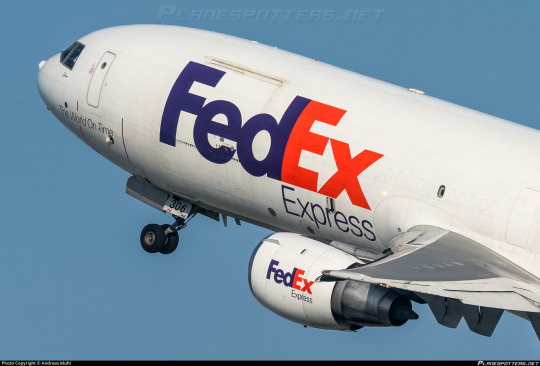
If you have ever sent or received a package, particularly if you live in the United States, you may be familiar with FedEx, and @magic-gps requested that I discuss their airplanes!
FedEx (founded and formerly known as Federal Express) is a massive network for transportation of mail and cargo, and Federal Express Express (okay, no, I can't call it that, FedEx is legally the full name even though we all know what it's really short for) is its airborne branch, making up the largest cargo airline by fleet and freight tonnes conveyed in the entire world. Their largest customer is the US Postal Service, with whom they have an exclusive contract - any USPS air mail is carried by FedEx Express - but they also fly for countless other clients. They cover so much ground (air) that they not only have a dozen hubs but an additional SUPERHUB, located in Memphis. They're what DHL is for Europe but doing bigger numbers, and that's with UPS, Atlas Air, and Kalitta Air to compete with. Although they're based in the US, their website claims that their destinations include every US zip-code, plus "over 220" countries and territories. There are 195 internationally recognized countries at present. I don't think saying they fly everywhere is even really hyperbole at this point.
FedEx's fleet is massive and eclectic. They have the world's largest cargo fleet, with 650 planes (which are named by employees, frequently after their children). Add in FedEx Feeder, a second fleet of small propeller airplanes dry-leased to local carriers for use ferrying small loads to the full-size jets, and there's a total of 699 FedEx liveries in the skies with 88 more on order. They occupy whole swathes of tarmac. They're everywhere. Like snails after the rain.

Oh, and apparently this livery was designed by Lindon Leader (what a name) of Landor Associates, the prolific and highly regarded design firm responsible for hits like the SAS belly stripe livery and misses like JAL's two previous designs. I have higher standards for liveries that are just absolutely everywhere, so let's see if Landor was able to live up to them.
I'm going to be specifically talking about, because I presume this is what the requester meant, the livery FedEx adopted in 1994. The timeline of this is interesting, because the name of the airline stayed Federal Express until 2000, when the entire company rebranded from Federal Express to FedEx and added the redundant 'Express' to the airline's name. I've always thought that was very funny, and while that's charming to me I don't think I should be encouraging things like this. It's just sloppy and a bit weird to say.
Before they adopted the livery they did briefly trial a new logo. From 1991 to 1994 they had this!
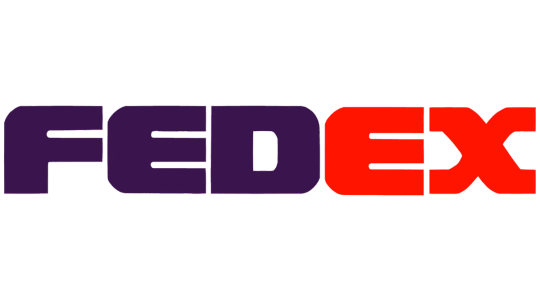
Boy do I not like that! It's significant to the history of the company in that it shifted the colorscheme from indigo and burgundy to purple and orange, except that the difference in brightness here is really almost upsetting and the logo itself is...it looks like that. It's very TRON somehow. I don't find the tackiness pleasant. It's just ugly. The typeface they chose is bad. The wriggly X is nice but every other letter looks a unique sort of hideous, with the E in particular looking like a rake made of sponge which has been placed in water and left to soak. Thankfully they moved on quickly, replacing this logo at the same time as their livery.
The fact that there's six years between the visual rebrand and official renaming is interesting. Federal Express was already colloquially known as FedEx before the official renaming, and used it in their branding, but they weren't legally FedEx yet, so for that little span their planes bore both names.
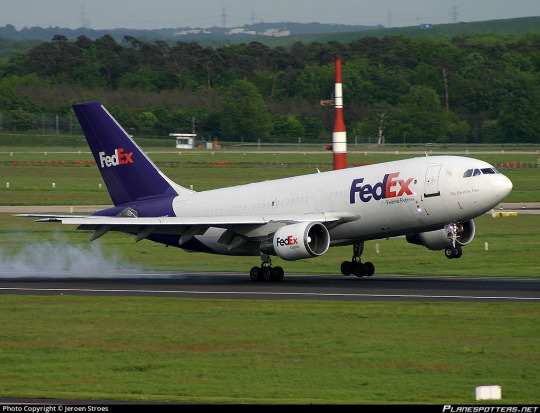

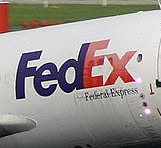
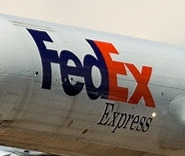
This adolescent period in the life of modern FedEx featured the 'Federal Express' subtitle in this serif mystery font which I haven't seen mentioned at all anywhere. I couldn't find many more pictures with the full 'Federal Express', but there's a scattering of seriffed planes out there, it seems. It looks a lot better with the 'Federal' taken out just by virtue of legibility, and I have to say I'm very keen on the way the subtitle is offset to align with the start of the E. It looks nice and aerodynamic. When the first word is taken out it has the extra benefit of lining 'Express' up with the 'Ex' that stands for it.
But there it is! The FedEx logo. Adopted in 1994, considered a contender for the best logo ever made, winner of over 40 awards.
I want to disclaim for a moment. I think it's always been somewhat implicit that my opinions are just one manifestation of the infinite variability of human thought and inevitably subjective but I do need to re-stress this now: these are my own hot takes. My opinion is not legally binding. Lindon Leader is an incredibly accomplished designer and I'm not even a designer at all. There is a reason that FedEx's logo is so widely acclaimed. My criticism of it is not an attempt to contest its legacy, and is - again - just my opinion. And it is an opinion colored not only by the fact that I'm an amateur, and by the fact that my tastes are different from other people's, but by the fact that this logo is quite literally older than I am, and tastes have most certainly evolved since then.
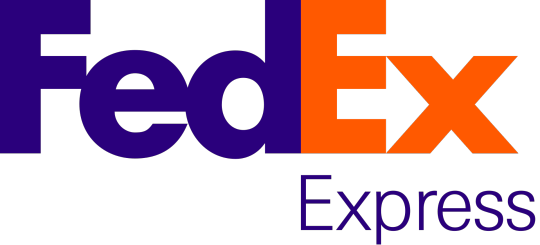
I think the FedEx logo is...okay. I certainly do not despise it, but I would stop very short of calling it the best logo ever. I'm going to talk about why I'm so underwhelmed by it, and it's going to sound like I don't like this logo for a bit, but if you power through that you will see that my opinion about it isn't as straightforward as the sum of my opinions about its parts.
The fantastic thing about this particular logo is that it's easily the most-discussed and best-documented bit of branding I've yet covered, so it was a delight to research. I didn't even have to call in my font wizard, for example, because Leader explicitly states what it is in this interview - a proprietary typeface heavily inspired by Univers 67 Bold Condensed and Futura Bold. I actually like Futura (the Cyrillic version is one of my favorite Cyrillic typefaces) but don't love Univers 67 - it reminds me way too much of the handwriting style I was drilled in at school. US schools have truly heinous taste in the penmanship they teach, and much like how Parker cursive inherently reminds me of third grade, Univers 67 feels to me like an adult version of something I've long since outgrown. The design of the letterforms here, with the exaggerated x-height and all the lines (crossbars included) having a uniform thickness of 'very', reminds me of the posters on the walls of elementary school classrooms.

Take a look at this. The green line is hypothetically where the baseline should be, but the E and D descend slightly below it. According to my font wizard this is fairly common as an attempt to some sort of visual trick, but I don't like it. I can make it out from a distance and it significantly bothers me.
Speaking of misaligned, I've always felt like the vertical line on the E was slightly wider than that on the D, but had dismissed this line of thought as an optical illusion - the darker color and the lack of detail at the top, plus the lack of gaps at any point in the E, artificially make the D look narrower than it is. I tried lining them up, and I was right, it's an optical illusion. I still hate it. What isn't an optical illusion is that the middle line on the E is thicker than the second line on the F - again, hate it!
And I just don't like this font! It's like if they fed different fonts to a neutral network and had it invent a weight bolder than bold, like the neural-network generated upperer and lowerer cases. I'm aware of the existence of ultra bold weights, and I'm not talking about those, because those are regular ugly and clearly made by humans. This looks like an algorithm expanded the letters until they were touching.
But the touching bit is intentional. The FedEx logo is hiding a little secret, perhaps the most frequently cited reason for why it's so beloved. Between the E and X, Leader slipped in an inconspicuous arrow.
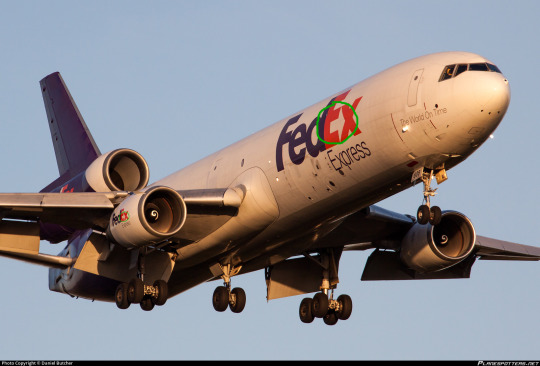
And I can't pretend this isn't really clever. It's subtle but once you see it you can never unsee it. My problem is that one feature doesn't make something good on its own, particularly when it's something you can easily miss at first. The Sneeze interview linked earlier sort of implies Leader built the font in large part around the idea of the arrow, and I find that a little problematic. Sometimes an idea is so fantastic you just can't let go of it, but when you're designing something you just can't be myopic like that. And, to be clear, I don't think Leader sacrificed the aesthetics of the wordmark to accommodate the arrow. I'm sure he personally thinks this font is beautiful. But when I evaluate it for myself, I can't allow one good feature to overpower my own dislike for the font overall, even if it is legitimately clever.
I do have some nice things to say, though. Well, mostly one nice thing. I love the color scheme. I think the purple and orange shades here are a wonderful choice, an uncommon one but one that manages to be a visually pleasing combination. If either of the shades were less saturated, or the purple were brighter, it would lose its cohesion, but Leader chose the perfect shades to bring out the best in each other. The old red and purple shades were absolutely hideous, but he transformed them into something great.
But at the end of the day my opinion of the logo on a granular scale is irrelevant. And I don't say that because I'm in the minority here or because I'm not allowed to have an opinion or anything else of the like. It doesn't matter because the FedEx logo is older than me and it is FedEx. When I see something purple and orange, I think of FedEx first. Let me use an example by invoking something better left dead.
In 2018 the Overwatch League, an esports league based around the maelstrom of poor decisions which is Blizzard's video 'game' Overwatch, played its first season. A charter member was the Florida Mayhem, a team which was in all honesty sort of a joke (though not exciting enough to live up to their name). I stopped following OWL after the first season, so I'm not sure if any of this has changed, but they finished second-to-last, made some very questionable choices on the management end, and were representing Florida. All of these facts are ontologically comedic. But above all, these were their team colors.
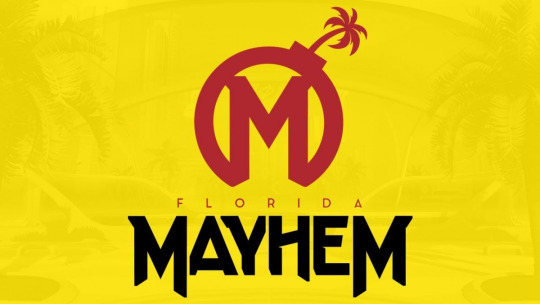

So, this creates the clear issue demonstrated above. Certain brands are so culturally entrenched that even a passing similarity in visual identity makes you immediately look like a pastiche, even if you're otherwise distinct. Mayhem's branding is, in my opinion, way better than McDonalds's, but it was still the right move when they changed to a completely unrecognizable color scheme in 2020. You just see some things and immediately recognize them.
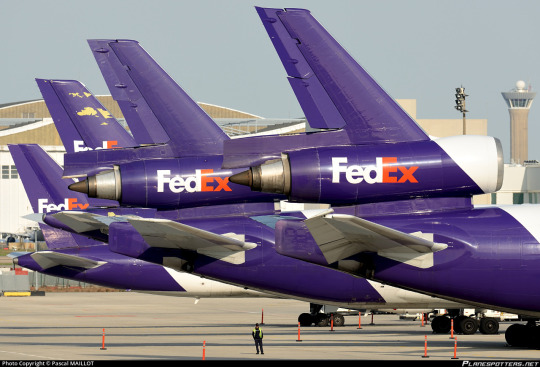
The cultural specter of the FedEx logo is very useful to the FedEx livery. As long as you do not royally mess up - which they have not - a FedEx plane will immediately resemble a FedEx package, even if it doesn't actually look like one, since they're mostly white.
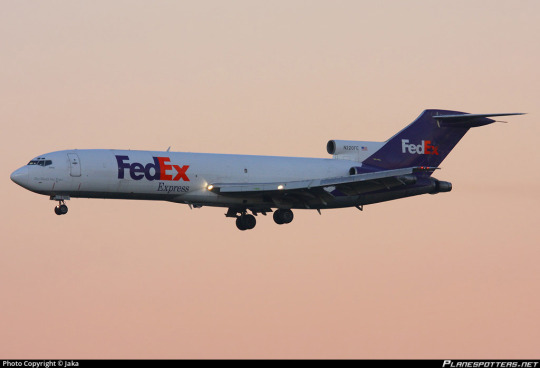
...well, okay, the planes are also mostly white. And I'll be honest, on the 727? This plane isn't half bad. The clean line of the t-tail makes this sort of straight-line-down livery look so much better, and the placement of the wordmark in front of the heavily swept wings keeps the white tube from looking quite so much like a white tube.
But the 727 isn't the only airframe they fly. They're the largest operator of six separate types, most of which are fully retired from passenger service, including the MD-11. Their MD-11s are literally the only trijets you'll see around in the US these days - they only started retiring their DC-10s in 2021, nearly ten years after they flew their last passenger flight. They're pretty unusual among large cargo airlines in that they flew the 747 for just over five years, and not particularly on their own initiative, having acquired a few from a merger with the Flying Tiger Line. So the way the livery looks on the 727 doesn't tell the whole story.
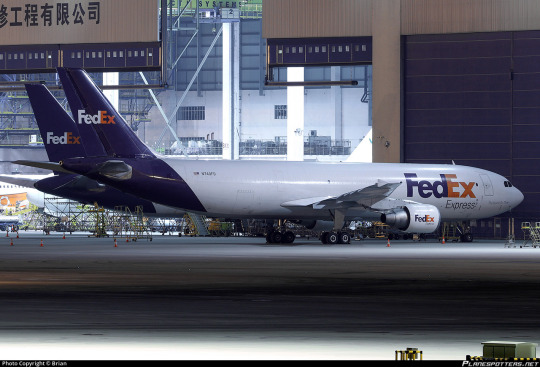
Okay. So that...is a couple of white tubes. That's somewhat unfortunate.
I want to clarify that, while this style of livery has become increasingly popular over time, culminating in its codification as an outright trend in the late 2010s and early 2020s, FedEx adopted this livery in 1994. It is wrong to say that the FedEx livery resembles TAM, Lufthansa, or Icelandair, and more correct to say that all of the above carriers are wearing a style similar to FedEx (though Qantas and MALÉV came first). Despite the fact that I've been known to call these 'Lufthansesque', Lufthansa didn't invent this style and didn't do it best. Still, doing it earlier doesn't excuse it.
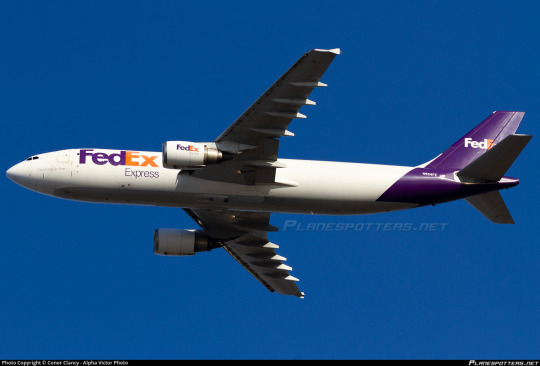
FedEx in particular suffers from the rear-heaviness issue. Though they have a larger logo which balances it out better than some (Lufthansa), it's kind of countered by the fact that FedEx exclusively operates planes I'd consider on the long and thin side. It makes the white look all the more dominant on the airframe.
FedEx does take one measure to mitigate this - the undersides are painted grey (in a style I've been calling 'Deltalike' to myself even though Delta absolutely did not do it first) instead of being the same white as the rest of the fuselage with the purple fully wrapping around. Also, they have the line remain straight on the third engine of trijets, instead of committing to one shade or the other, as older trijet liveries frequently did.
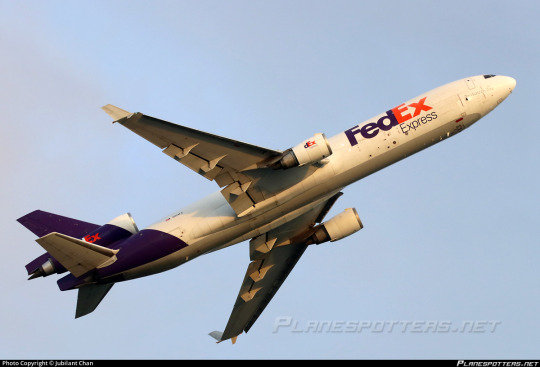

Compared to an ASL Airlines lease which keeps the underside white and the purple as a contiguous loop, this creates a much more streamlined look. But it's not enough to save this.
And I think what bothers me the most is how at odds this is with the thing people say is so brilliant about the logo - the arrow.
Arrows are, as Leader pointed out in his interview, definitely not a new phenomenon in airline liveries. Hell, we even had Arrow Air.

But there's a reason for that. Arrows represent forward movement. They're fundamentally indicative of speed, efficiency, and polish. And airplanes are more or less shaped like arrows, when you think about it.

Something being done very frequently doesn't make it somehow creatively bereft. And it's not like only painting the tail and the big of fuselage directly below it is reinventing the wheel either.
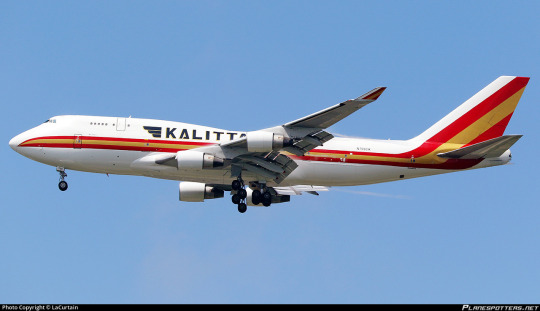
Cheatlines, and hockey sticks especially, were not a particularly new thing when my perennial example of 'boring idea, good execution', Kalitta Air, rolled out in the 1980s. In fact, they were done to death. But Kalitta Air's choice in color and shape, use of proportions, and stylish logo set it apart from every other airline to use this style.

There is a reason arrows are so common. They are speed and precision and kinetic energy. When you refuse to consider making something common your own, you often shoot yourself in the foot. With the logo constructed, with the motto 'the world on time' written on the nose of each plane, absolutely nobody would turn up their nose at FedEx having an arrow motif on its livery.

Ultimately, I'm a bit sad, because the FedEx logo, while I don't like a lot of the choices made in regards to the font, would provide a truly fantastic jumping off point for a livery that would elevate it beyond the point anyone could ever dismiss it as being part of a crowd of very similar designs, the way I have by lumping it in with Lufthansesques. Arrows, being a fundamentally long and tall shape, would also avoid the pitfalls of a livery type which I have already on multiple occasions critiqued for inherently creating a look of rear-heaviness, particularly on longer and thinner airframes, especially when the color used is a dark shade to contrast a white base.
That said, the FedEx livery gets a bit of a free pass where something like Lufthansa doesn't. FedEx's logo is so ubiquitous that unless you actively interfere with or muddle it, any plane bearing it will immediately be recognizable as a FedEx plane the same way a truck or package is. As a branding exercise it is certainly successful. It looks clean, it's by no means exceptionally ugly, it does its job...but it is so rich with potential and so impoverished in execution. Doesn't it just look like this plane isn't taking off, but being pulled by the weight of its purple slice towards the ground?

I'm giving FedEx a D+.
I don't feel good about doing this. I think this is an opinion which is not only contentious but downright unpopular. But as I've mentioned a few times my grades take into account more than just broad aesthetic appeal. Branding and environment factor in, but what also factors in is, as I said in discussing Saudia, wasted potential and a refusal to capitalize on what you have that's clearly good. When I graded Air Astra down for not reaching its potential I meant it as a kind gesture, not even a sort of tough love but an acknowledgment that I like what they have and I know they'll do better.
FedEx, however, is just disappointing. For the frequently cited best logo of all time, this is just unacceptable. This verdict brings me no joy, but the fact that this logo is so beloved doesn't mean I can go easy on it - to the contrary, it had a lot to live up to, and it just didn't.
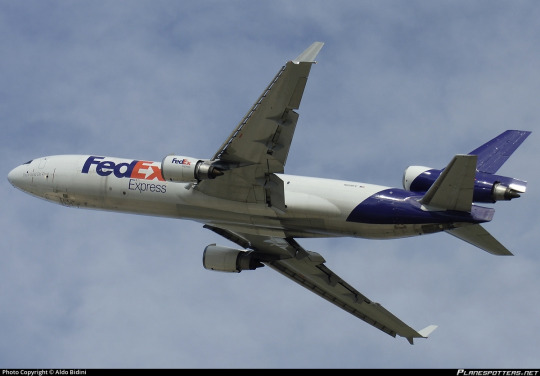
#tarmac fashion week#grade: d+#era: 1990s#era: 2020s#era: 2010s#era: 2000s#region: north america#region: united states#fedex#kalitta air#cargo carriers#requests#lufthansa line#landor portfolio#skywriting
28 notes
·
View notes
Photo

DHL(Kalitta Air)Boeing777 #dhl #kalittaair #boeing777 #centrair #セントレア #中部国際空港 #aviacao #aviação #airplane #airplanelovers #airplanelovers #amantesdaaviacao #spotters #aviationspotter #spotteraviação #brasileirosfotógrafosnojapão #fotografobrasileironojapao #spotterbrasileirosnojapao #spotterbrasil #avgeek #apaixonadosporaviacao #planespotting #planespotter #planespotters #pontoalternativa https://www.instagram.com/p/Chgv0w2vN07/?igshid=NGJjMDIxMWI=
#dhl#kalittaair#boeing777#centrair#セントレア#中部国際空港#aviacao#aviação#airplane#airplanelovers#amantesdaaviacao#spotters#aviationspotter#spotteraviação#brasileirosfotógrafosnojapão#fotografobrasileironojapao#spotterbrasileirosnojapao#spotterbrasil#avgeek#apaixonadosporaviacao#planespotting#planespotter#planespotters#pontoalternativa
1 note
·
View note
Text

Top Fuel Tuesday; "Air Doug" Kalitta's "Mac Tools" Toyota
17 notes
·
View notes
Text

airsLLide No. 16187: N306GB, Lockheed L-1011 TriStar 200F, Arrow Air, Miami-International, March 2, 1999.
Unlike its direct rival, the McDonnell Douglas DC-10, the Lockheed TriStar only saw very limited use in the secondhand freighter market. Only a handful of the jets were converted to commercial cargo aircraft or military transports, mostly for Arrow Air (Miami), American International Airlines / Kalitta Air (Detroit-Willow Run) and the RAF Royal Air Force in the UK.
N306GB, formerly passenger carrying A4O-TY with Gulf Air, was one of Arrow Air's three TriStar freighters it employed between 1996 and 2003/04. Compared to the DC-10, the TriStar's success as a freighter was reportedly hampered both by its performance as well as a restricted payload capacity of 55 tons (due to the load limits supported by the floor), compared to the nearly 80 tons of a DC-10.
2 notes
·
View notes
Text
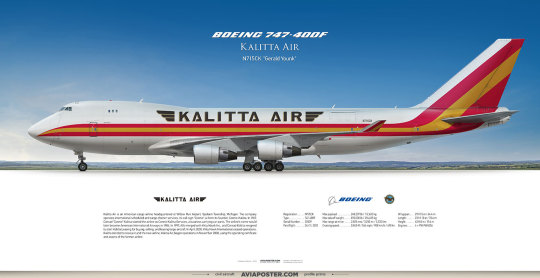
Boeing 747-400F Kalitta Air
Registration: N715CK Named: Gerald Younk Type: 747-4B5F Engines: 4 × PW PW4056 Serial Number: 32809 First flight: Oct 11, 2002
Kalitta Air is an American cargo airline headquartered at Willow Run Airport, Ypsilanti Township, Michigan. The company operates international scheduled and cargo charter services. Its call sign "Connie" is from its founder, Connie Kalitta. In 1967, Conrad "Connie" Kalitta started the airline as Connie Kalitta Services, a business carrying car parts. The airline's name would later become American International Airways in 1984. In 1997, AIA merged with Kitty Hawk Inc., and Conrad Kalitta resigned to start Kalitta Leasing for buying, selling, and leasing large aircraft. In April 2000, Kitty Hawk International ceased operations. Kalitta decided to rescue it and the new airline, Kalitta Air, began operations in November 2000, using the operating certificate and assets of the former airline.
Poster for Aviators. aviaposter.com
#aircraft#airliners#aviaposter#boeingpilot#boeingfans#boeingaircraft#boeing747#b747#jumbojet#queen of the skies
6 notes
·
View notes
Photo
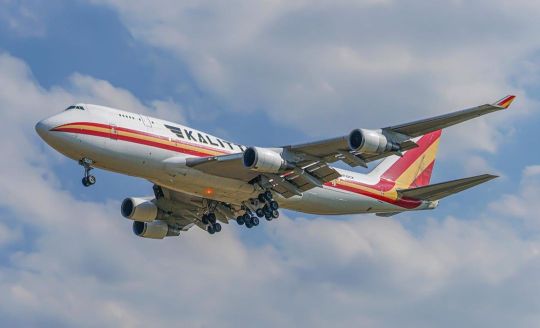
🛬 KALITTA AIR BOEING 747-446 (BCF) N742CK 📸 LIEGE AIRPORT 🗓️ 2018/06/15 #photographedbyhermanwalraet© #hewapic© #boeing #747 #boeing747 #boeinglovers #kalittaair #cargo #luik #liege #airport #aviation #aviationlovers #aviationphotography #vliegtuig #vliegtuigspotten #flight #landing #instaflight #sky #skyline #hewapic #photography #photo #foto #fotografie #fotografia #kalitta (bij Liège Airport) https://www.instagram.com/p/Ckvq_8qISxL/?igshid=NGJjMDIxMWI=
#photographedbyhermanwalraet©#hewapic©#boeing#747#boeing747#boeinglovers#kalittaair#cargo#luik#liege#airport#aviation#aviationlovers#aviationphotography#vliegtuig#vliegtuigspotten#flight#landing#instaflight#sky#skyline#hewapic#photography#photo#foto#fotografie#fotografia#kalitta
0 notes
Text
https://impactnews-wire.com/on-the-wire/f/ait-worldwide-logistics-forms-craf-partnership-with-kalitta-air
1 note
·
View note
